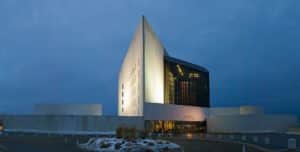The legacy of the late architect I.M. Pei stretches from west to east, from the Louvre museum to his native China, and includes several Boston landmarks that have shaped key parts of the city.
Pei, who died earlier this week at the age of 102, added elegance to landscapes worldwide with powerful geometric shapes and grand spaces, from a trapezoidal addition to the National Gallery of Art in Washington, D.C., to the giant glass pyramid at the Louvre.
Ieoh Ming Pei was born on April 26, 1917, in Canton, China, the city now called Guangzhou. He came to the United States in 1935 with plans to study architecture, then return to practice in China. However, World War II and the revolution in China prevented him from going back.
Inspired by the 1930s building boom as a schoolboy in Shanghai, Pei studied architecture at MIT and Harvard University. He advanced from his early work of designing office buildings, low-income housing and mixed-used complexes to a worldwide collection of museums, municipal buildings and hotels.
He established his own architectural firm in 1955, a year after he became a U.S. citizen. He remained based in New York City. Among the firm’s accomplishments are the Jacob Javits Convention Center in New York City and the United States Holocaust Memorial Museum in Washington.
His big break was in 1964, when he was chosen over many prestigious architects, such as Louis Kahn and Ludwig Mies van der Rohe, to design the John F. Kennedy Memorial Library in Dorchester’s City Point.
At the time, Jacqueline Kennedy said all the candidates were excellent, “But Pei! He loves things to be beautiful.” The two became friends.
Other notable Boston-area designed include the West Wing at the Museum of Fine Arts, the master plan for downtown Boston’s Government Center and MIT’s 295-foot Green Building. Henry Cobb, a principal at Pei’s firm, also designed the John Hancock Tower.
A slight, unpretentious man, Pei developed a reputation as a skilled diplomat, persuading clients to spend the money for his grand-scale projects and working with a cast of engineers and developers.
Some of his designs were met with much controversy, such as the 71-foot (22-meter) faceted glass pyramid in the courtyard of the Louvre museum in Paris. Then French President Francois Mitterrand, who personally selected Pei to oversee the decaying, overcrowded museum’s renovation, endured a barrage of criticism when he unveiled the plan in 1984.
Many French vehemently opposed such a change to the symbol of their culture, once a medieval fortress and then a national palace. Some resented that Pei, a foreigner, was in charge.
But Mitterrand and his supporters prevailed and the pyramid was finished in 1989. It serves as the Louvre’s entrance, and a staircase leads visitors down to a vast, light-drenched lobby featuring ticket windows, shops, restaurants, an auditorium and escalators to other parts of the vast museum.
Two of his sons, Li Chung Pei and Chien Chung Pei, former members of their father’s firm, formed Pei Partnership Architects in 1992. Their father’s firm, previously I.M. Pei and Partners, was renamed Pei Cobb Freed & Partners.
Pei’s wife, Eileen, whom he married in 1942, died in 2014. A son, T’ing Chung, died in 2003. Besides sons Chien Chung Pei and Li Chung Pei, he is survived by a daughter, Liane.




 |
| 


